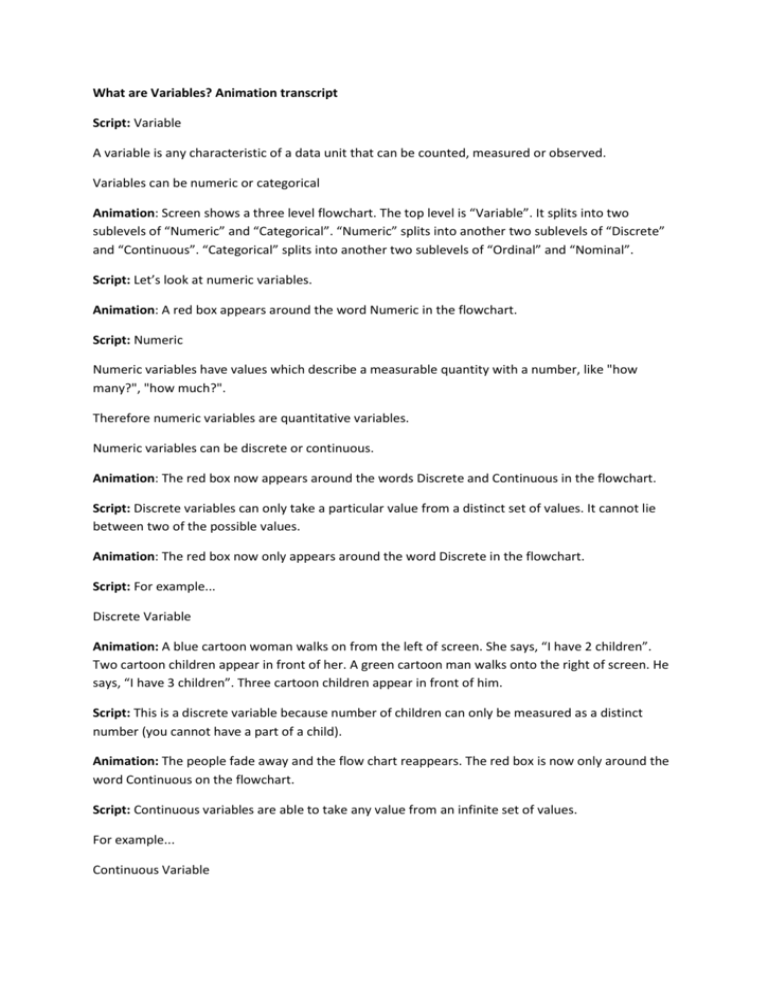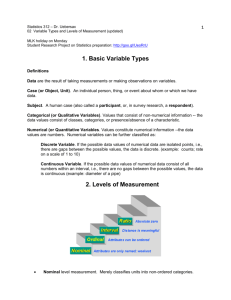Transcript ( 30kb)
advertisement

What are Variables? Animation transcript Script: Variable A variable is any characteristic of a data unit that can be counted, measured or observed. Variables can be numeric or categorical Animation: Screen shows a three level flowchart. The top level is “Variable”. It splits into two sublevels of “Numeric” and “Categorical”. “Numeric” splits into another two sublevels of “Discrete” and “Continuous”. “Categorical” splits into another two sublevels of “Ordinal” and “Nominal”. Script: Let’s look at numeric variables. Animation: A red box appears around the word Numeric in the flowchart. Script: Numeric Numeric variables have values which describe a measurable quantity with a number, like "how many?", "how much?". Therefore numeric variables are quantitative variables. Numeric variables can be discrete or continuous. Animation: The red box now appears around the words Discrete and Continuous in the flowchart. Script: Discrete variables can only take a particular value from a distinct set of values. It cannot lie between two of the possible values. Animation: The red box now only appears around the word Discrete in the flowchart. Script: For example... Discrete Variable Animation: A blue cartoon woman walks on from the left of screen. She says, “I have 2 children”. Two cartoon children appear in front of her. A green cartoon man walks onto the right of screen. He says, “I have 3 children”. Three cartoon children appear in front of him. Script: This is a discrete variable because number of children can only be measured as a distinct number (you cannot have a part of a child). Animation: The people fade away and the flow chart reappears. The red box is now only around the word Continuous on the flowchart. Script: Continuous variables are able to take any value from an infinite set of values. For example... Continuous Variable Animation: The chart is removed and the woman and man reappear facing forward. A ruler appears between them extending from the bottom of the screen up to the top of the screen, and beyond. The woman says, “I am 170cm tall” and a red line marks 170cm on the ruler. The man says, “I am 182.5cm” tall and a second red line marks 182.5cm on the ruler. Script: Height is an example of a continuous variable because it can be measured anywhere along a continuum. As numeric variables are expressed as a numeric value, they can be ordered from lowest to highest. The distance between each value can be calculated and a range of other calculations can be performed. Animation: Then a line marks the distance between the two height markers on the ruler and reads 12.5cm. The people and ruler fade away. The flowchart reappears with the red box now around the word Categorical on the flowchart. Script: Categorical variables. Categorical variables have values that describe a "quality" or "characteristic" of a data unit, like 'what type?' or 'which category?’. Categorical variables fall into mutually exclusive (in one category or in another) and exhaustive (include all possible options) categories. Therefore, categorical variables are qualitative. Animation: The flowchart now shows the red box around the words Ordinal and Nominal. Script: Categorical variables can be ordinal or nominal. Animation: The flowchart now shows the red box around the word Ordinal. Script: Ordinal variables take on values that can be logically ordered or ranked. For example... Job Satisfaction Animation: The flowchart disappears and the woman and man reappear. The woman says, “I am very satisfied with my job”. The man says, “I am dissatisfied with my job”. A list of five options appears between them, reading from top to bottom: “Very Satisfied, Satisfied, Neither, Dissatisfied, Very Dissatisfied”. A blue line points from the woman to the words “Very Satisfied”. A second blue line points from the man to the word “Dissatisfied”. Script: Ordinal variables can be ranked higher or lower than another, but do not necessarily establish a numeric difference between each category. Animation: The people fade away and the flowchart reappears. The red box now appears around the word Nominal on the flowchart. Script: Nominal variables take on values that are not able to be organised in a logical sequence. For example… Nominal Variable Animation: The flow chart disappears and the woman and man reappear. The woman says, “I have blue eyes”. The man says, “I have green eyes”. Script: "Colour of eyes" is a nominal variable because it is not possible to place the values in a logical order or sequence. Let’s summarise what we have discussed. The variables we looked at were "Number of children", "Height of person", "Job satisfaction", "Eye colour". Animation: A summary table appears. It shows the variable names and type of variable: Number of Children (discrete), Height (continuous), Job Satisfaction (ordinal) and Eye colour (nominal), along with the woman’s responses: 2 children, 170cm tall, very satisfied and blue eyes; and the man’s responses: 3 children, 182.5cm tall, dissatisfied and green eyes. Animation: End







